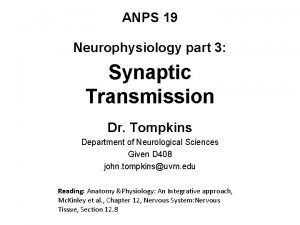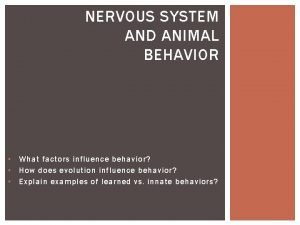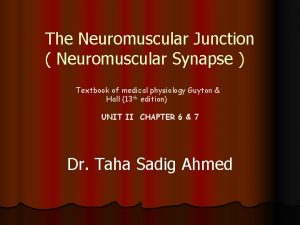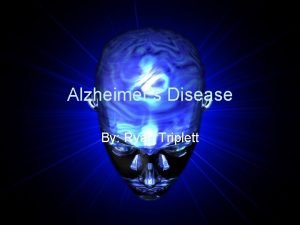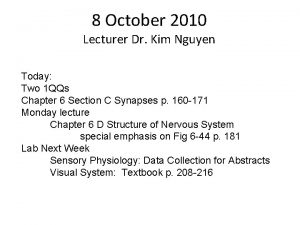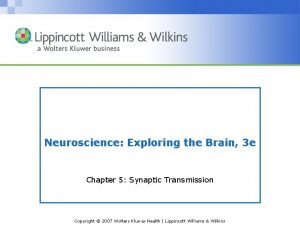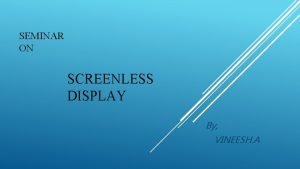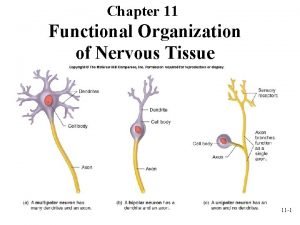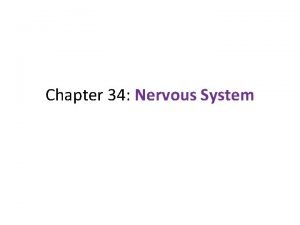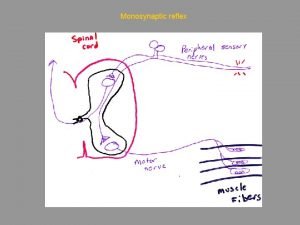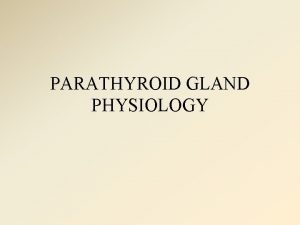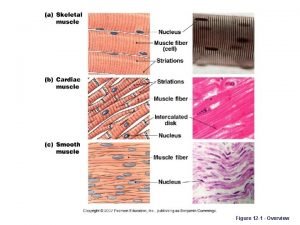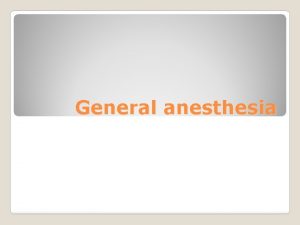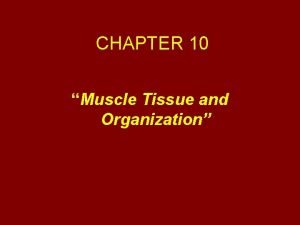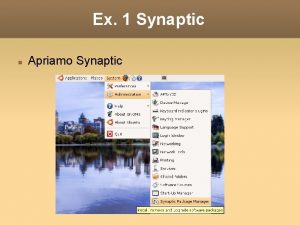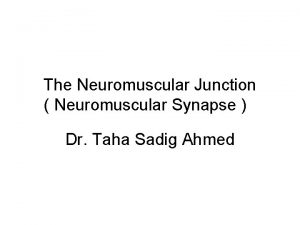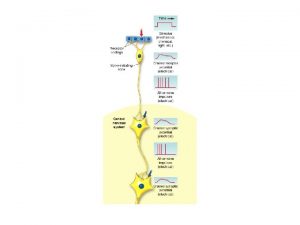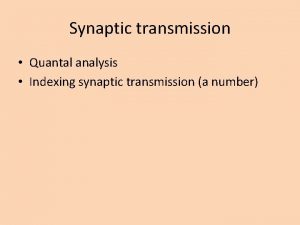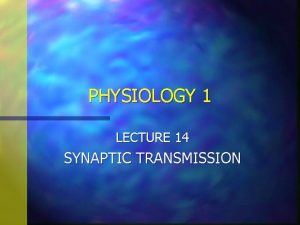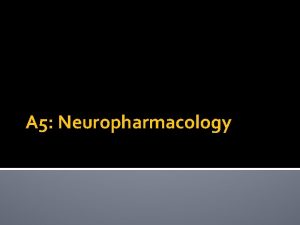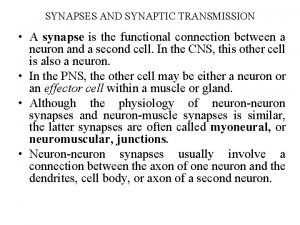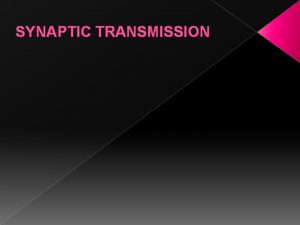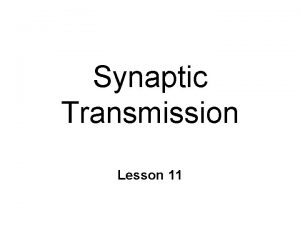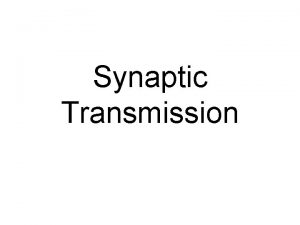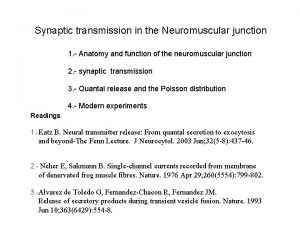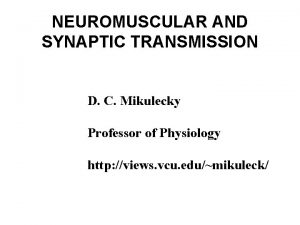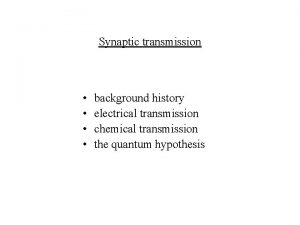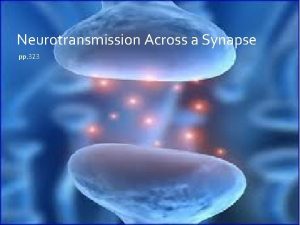Neuromuscular transmission Synaptic transmission n Synapse is the


















- Slides: 18

Neuromuscular transmission

Synaptic transmission *** n Synapse is the junction between two neurones where electrical activity of one neurone is transmitted to the other

Motor Unit • Motor Unit : is the motor neuron and all the muscle fibers it supplies all of these fibers will have the same type (either fast twitch or slow twitch). When a motor unit is activated

The Neuromuscular junction consists of Axon Terminal : contains around 300, 000 vesicles which contain the neurotransmitter acetylcholine (Ach). Synaptic Cleft : 20 – 30 nm ( nanometers ) space between the axon terminal & the muscle cell membrane. It contains the enzyme cholinesterase which can destroy Ach.

The Neuromuscular junction consists of Ø Ø Ach is synthesized locally in the cytoplasm of the nerve terminal , from active acetate (acetylcoenzyme A) and choline. Then it is rapidly absorbed into the synaptic vesicles and stored there. The synaptic vesicles themselves are made by the Golgi Apparatus in the nerve soma ( cell-body). Then they are carried by Axoplasmic Transport to the nerve terminal , which contains around 300, 000 vesicles.

Acetylcholine (1) Ø Ø Ø Ach is synthesized locally in the cytoplasm of the nerve terminal, from active acetate (acetylcoenzyme A) and choline. Then it is rapidly absorbed into the synaptic vesicles and stored there. The synaptic vesicles themselves are made by the Golgi Apparatus in the nerve soma ( cell-body). Then they are carried by Axoplasmic Transport to the nerve terminal , which contains around 300, 000 vesicles. Each vesicle is then filled with around 10, 000 Ach molecules.

Steps involved: n n n AP at the synaptic knob -----» Ca channels open (increase Ca permeability) -----» release of neurotransmitter (NT) from synaptic knob to synaptic cleft -----» NT combines with specific receptors on the other membrane -----» postsynaptic potential -----» AP will result

Neuromuscular transmission

Neuromuscular transmission *** n n Transmission of impulse from nerve to muscle (neuromuscular junction) Steps: AP at nerve knob -----» increase Ca permeability (Ca inter synaptic knob) -----» release of Acetylcholine (Ach) ----» Ach combine with receptors on motor end plate -----» Na permeability increase -----» end plate potential develop -----» AP spread on the membrane -----» muscle contraction

Molecular basis of muscle contraction *** n Anatomical consideration: n n n Muscle fibre Sarcomere Myosin (thick filament): n n Cross-bridge Actin (thin filament) n n Regulatory protein: (Troponin, Tropomyosin) Actin

Events of muscle contraction: *** n n Acetylcholine released by motor nerve » » » EPP » » » depolarization of CM (muscle AP) » » » Spread of AP into sarcoplasmic reticulum » » » release of Ca into the cytoplasm » » » Ca combines with troponin » » » troponin pull tropomyosin sideway » » » exposing the active site on actin » » » myosin heads with ATP on them, attached to actin active site » » » Resulting in formation of high energy actin-myosin complex » » » activation of ATP ase (on myosin heads) » » » energy released, which is used for sliding of actin & myosin



Events of muscle contraction: n n When a new ATP occupies the vacant site on the myosin head, this triggers detachment of myosin from actin The free myosin swings back to its original position, & attached to another actin, & the cycle repeat its self

Events of muscle contraction: n n n When ca is pumped back into sarcoplasmic reticulum » » » ca detached from troponin » » » tropomyosin return to its original position » » » covering active sit on actin » » » prevent formation of cross bridge » » » relaxation

Muscle contraction **** n 1 - simple muscle twitch: The mechanical response (contraction) to single AP (single stimulus) n 2 - Summation of contraction: Spatial summation: the response of single motor unites are added together to produce a strong muscle contraction Temporal summation: when frequency of stimulation increased (on the same motor unite), the degree of summation increased, producing stronger contraction


Types of muscle contraction: n 1 - Isometric contraction: n n No change in muscle length, but increase in muscle tension (e. g. standing) 2 - Isotonic contraction: n Constant tension, with change in muscle length (e. g. lifting a loud)
 Chemical and electrical synapse
Chemical and electrical synapse Chemical synapses
Chemical synapses Synaptic transmission quiz
Synaptic transmission quiz Neuromuscular junction
Neuromuscular junction Transmission across a synapse
Transmission across a synapse Capacities newborns display
Capacities newborns display Thin filament
Thin filament Ryan triplett
Ryan triplett Synaptic gutter or trough
Synaptic gutter or trough Synaptic integration
Synaptic integration Lippincott williams & wilkins
Lippincott williams & wilkins Virtual retinal display seminar report
Virtual retinal display seminar report Function of multipolar neuron
Function of multipolar neuron Synaptic integration
Synaptic integration Neuromuscular junction
Neuromuscular junction Why does hypocalcemia cause tetany
Why does hypocalcemia cause tetany Figure 12-1
Figure 12-1 Definition of anesthesia
Definition of anesthesia Neuromuscular junction
Neuromuscular junction
